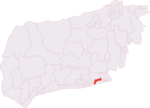Lancing, West Sussex

Lancing is a large coastal village and civil parish in the Adur district of West Sussex, England, on the western edge of the Adur Valley. It occupies part of the narrow central section of the Sussex coastal plain between smaller Sompting to the west, larger Shoreham-by-Sea to the east, and the parish of Coombes to the north. Excluding definitive suburbs it may have the largest undivided village cluster in Britain. However, its economy is commonly analysed as integral to the Brighton/Worthing/Littlehampton conurbation. Its settled area beneath the South Downs National Park covers 3.65 square miles (9.5 square kilometres; 2,340 acres), the majority of its land. The Lancing area is characterised by mid-rise coastal urban homes, farmland, and wildlife reserves of the northern chalk downs and River Adur estuary. There are non-religious structures that date back to the early 16th century. The population in 2002 was approximately 19,000 in 2002. In the 2011 census the population for Lancing and Coombes was recorded as 18,810. The village was a popular seaside resort in the mid-19th century. Summer tourist hallmarks are the traditional guesthouses on the A259 coast road, as well as a caravan/campsite in Old Salts Farm Road, and beach chair hire and ice cream businesses.
Excerpt from the Wikipedia article Lancing, West Sussex (License: CC BY-SA 3.0, Authors, Images).Lancing, West Sussex
Crabtree Lane, Adur
Geographical coordinates (GPS) Address Nearby Places Show on map
Geographical coordinates (GPS)
| Latitude | Longitude |
|---|---|
| N 50.832 ° | E -0.319 ° |
Address
Crabtree Lane
Crabtree Lane
BN15 9PQ Adur
England, United Kingdom
Open on Google Maps






